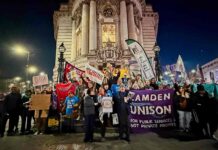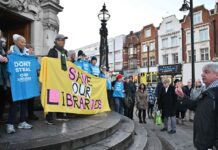
Lambeth Community Police Consultative Group have just released a report called ‘Whose Shout?’ examining the relationship between Lambeth’s residents and the police, investigating whose voices are not heard in the community when it comes to crime. ‘Crime’. That’s one big topic and imbued with political debate, from how many police we should have on the streets to how people should be punished. But don’t be put off – this is an important document and it’s here for you to read.
So what comes out of the report? First, it is clear that crime in the borough really has fallen – over 30% since 2002. But, conversely, fear of crime has gone up and, says the report, “Lambeth remains a high crime area, with the third most recorded offenses of all London boroughs in 2008-9”. Only 23% of residents feel consulted on crime and only 25% feel that the police and local groups are succesfully dealing with it.
In April 2009, a new statutary ‘duty to involve’ was imposed upon councils – so policing departments now have to listen to and actively involve the community they serve. But how to do that? There are already lots of different crime-based community groups in Lambeth – from Safer Neighbourhood Panels, which are split up per ward and provide residents with the opportunity to talk to their local Safer Neighbourhood Teams, to Neighbourhood Watch Groups and the Lambeth-wide CPCG. The CPCG was established after the Scarman Report in 1981 and has always been relatively innovative in its approach. It is a monthly meeting open to any Lambeth resident; a place for a lot of grandstanding, but it’s also one of the few forums in which people can have their say about policing in Lambeth.
But not everyone wants to get up and speak at a public meeting and clearly not enough people in Lambeth feel involved in decisions about crime. Catriona Robertson, the author of the report, has talked to all kinds of people through many different means to see what they think of the current situation – video vox pops on social housing estates, a focus group in Angell Town and online surveys. And, because naturally we do not all speak as one, there are a wide variety of local concerns – some feel uncomfortable walking past drug sellers outside KFC, others want more CCTV cameras and a Youth Parliament was even suggested so that more young people can have a say than in the current Youth Council.
‘Whose Shout?’ is open-minded in its suggestions for improvement in police-community relations. There should be “different methods of engagement” [what a terrible, jargony word ‘engagement’ is]. One suggestion is to involve young people by getting them to text Stop-and-Search experiences to the CPCG Monitoring Group and be texted back with action points. More knowledge and information needs to be accessible to a wider group of people and that means diversifying the means by which it is disseminated, from online forums and radio stations to pamphlets and public meetings with different formats.
Most importantly, people need to feel like something actually happens to their comments and complaints once they have been filed – they need feedback or the whole process feels futile. This report is a fascinating read…or a skim-through if you don’t have time to wade through 91 pages. Here’s hoping its recommendations don’t fall by the wayside.
The next CPCG meeting is at the Town Hall on July 6 at 6pm and there is a meeting of the Brixton Hill Safer Neighbourhood Panel tonight.







[…] Lambeth’s Community Police Consultative Group has produced a new report, titled Whose Shout?, about crime in the borough and people’s responses to it (thanks to Brixton Blog for the spot). […]
[…] Blogs and tweets from Lambeth people on the Whose Shout? report include a very good overview from Brixton Blog and a daring plunge into the statistics in the introductory chapter from Lurking About […]